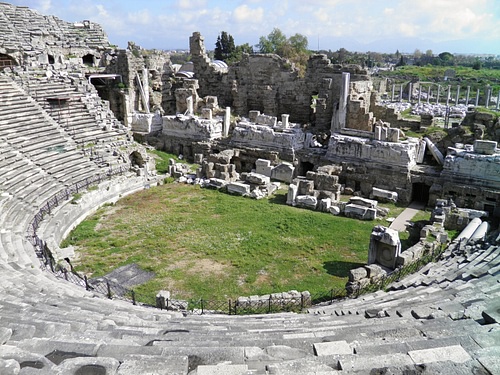Side
HİSTORY OF SİDE
Side (Σίδη) (meaning pomegranate) is located in the region of Pamphylia in Anatolia (modern-day Turkey) and was both a prosperous Aegean trading centre in Hellenistic and Romantimes and a base for Cilician pirates in the 1st and 2nd centuries BCE.
One of the first things you notice on arrival at the site is that modern Side is a tourist town. However, it is also one of the best preserved classical sites in Turkey. The ancient city of Side is found on a small peninsula measuring about 1 km by 400 m.
Historical Overview
Strabo tells us that the city of Side was founded around the 7th century BCE by Greekcolonisers from Kyme in Aeolis. The natural geography of the area made it an ideal place in Anatolia for trade and a harbour. Arrian tells us that the colonizers did not understand the dialect of the locals, indicating that the area was already inhabited. Arrian asserts that the indigenous language had a strong influence, though, and gradually became the primary language in Side. This is seen in several of the inscriptions in the local tongue uncovered at the site. The Hittites also have connections to the area as attested by other artefacts found such as a basalt column base.IN 333 BCE, ALEXANDER THE GREAT OCCUPIED THE SITE AND INTRODUCED THE POPULATION TO HELLENISTIC CULTURE.
Side has a history of great influence and personality. In 333 BCE, Alexander the Great occupied the site and introduced the population to Hellenistic culture which became the dominant tradition until the 1st century BCE. Ptolemy later overtook the site when he declared himself king of Egypt in 305 BCE. Side stayed under Ptolemaic control until it was captured by the Seleucid Empire in the 2nd century BCE. Side was freed from the control of the Seleucid Empire after the defeat of Hannibal and Antiochus the Great. Despite conflicts and changes in control, Side remained prosperous and even minted its own money from 188 BCE to the end of the 1st century BCE. In the 1st century BCE, Side also became an important base for the Cilician pirates and their slave trade and profited from this. With the defeat of the pirates, Side fell under the control of Rome and became part of the Roman Empire. Side began to decline around the 4th century CE with an influx of mountain invaders. It had prosperity on and off through the next few centuries before being abandoned around the 12th century CE.

Archaeological Site
Side is a site with a long history which has left behind numerous buildings and ruins for us archaeology and history fanatics to explore. The most complete ruin at Side is the theatrecomplex which is the largest in the Roman style in the region. It could seat around 15,000 people and was converted into an open-air sanctuary with two chapels during the Byzantine Era. The seats still contain the inscriptions of names of patrons and on occasion shows are still carried out there. The city walls also remain alongside the Hellenistic main gate. There are colonnaded streets with many of the marble columns still standing and many others nearby. The local museum is housed in the remains of the public bath house and elsewhere the agora and temple of Tyche from the 2nd century BCE are still visible. There are also the remains of a Byzantine hospital and a basilica and three temples. An aqueduct (probably supplied by water from the Melas River) and nymphaeum (an elaborate fountain building spanning three stories and decorated with marble reliefs) can also be seen in a fair state of preservation near the city gates.
The state agora is still visible within the sand dunes of the eastern beach at Side. It is an amazing site, surrounded by columns which held a giant cross in the centre during the Byzantine period. It would have been decorated with copies of Greek statues, some of which remain on display in the Side Museum. There may also have been a library at this site. The ancient harbour was constructed during the Hellenistic period and is located on the southeast part of the peninsula next to the temples of Athena and Apollo which are still standing in part on the beaches of Side.

The Museum at Side is located in what was once a 5th century BCE bath complex. The range of statues and coins in addition to the gardens, the view, and collection of inscriptions is wonderful. The statues are well preserved and the inscriptions well cared for and readable. There are also interesting reliefs of the Sidetan victory over an army from Pergamon in the 2nd century BCE and a number of ornate sarcophagi recovered from Side’s necropolis which is now no more. There are a number of amphorae which have been recovered from the waters around Side and some fragmented displays of the Sidetan language (mentioned previously) which remain undeciphered.
Archaeologists from Turkey began excavating the site in 1947 CE and continue to excavate there today. The archaeology department from the Anatolian University currently continues excavations at Side. One hundred archaeologists in 2012 CE were led by Professor Huseyin Alanyali in the preservation and restoration of the sites. They will continue work on the Temple of Apollo, the Temple of Type, the Temple of Dionysos, the Temple of Athena, and a basilica. There is also a team of 15 archaeologists being led by Professor Peter Scherrer from the archaeology department of Austrian Graz University who will be working alongside Turkish archaeologists on the eastern side of the site.




























